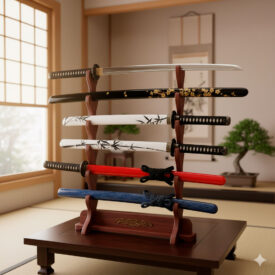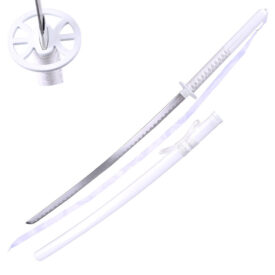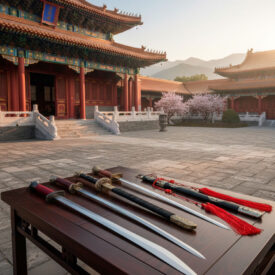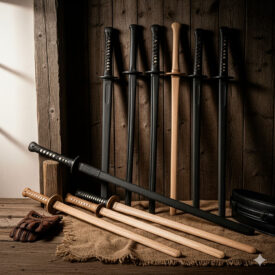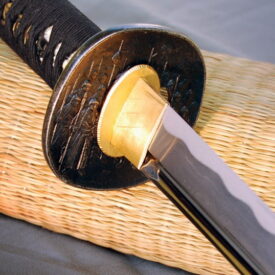Martial arts are a path of discipline, respect, and self-knowledge, where every tool used is much more than a simple inanimate object. They represent an extension of the practitioner’s spirit, a link to history, and a way to personal development. Within this universe of tools, bamboo katanas emerge as a fascinating and essential bridge between a glorious past and an innovative present. These practice weapons not only encapsulate centuries of Japanese heritage and the wisdom of ancient masters, but also embrace modern innovation, offering today’s practitioners an exceptional tool that honors history while meeting the demands of rigorous and safe training.
The essence of bamboo katanas lies in their ability to fuse traditional craftsmanship with contemporary techniques and materials, resulting in significantly improved performance. Despite their evolution, they maintain their deep cultural significance, adapting to today’s training needs without losing their soul. Furthermore, they represent an ecological and conscious option for the world of martial arts, promoting sustainable practices that respect the environment—a value increasingly appreciated across all disciplines.
In this extensive article, we will delve into the fascinating world of bamboo katanas, exploring their historical origins, the artisanal mastery that defines them, the innovations that have transformed them, their undeniable visual and ergonomic appeal, their deep cultural significance in disciplines such as Kendo, their tangible benefits for training, key tips for their selection and maintenance, and their crucial role in sustainability. Whether you are a Kendo practitioner, a martial arts enthusiast, or simply someone interested in the fusion of tradition and modernity, this is your place.
Origins and History: Bamboo as the Foundation of Training
The incorporation of bamboo into the design and manufacture of practice katanas is a captivating story of ingenuity, necessity, and adaptation. Ancient Japanese swordsmiths, masters in observing nature and applying its resources, quickly recognized the unique properties of bamboo. Its impressive flexibility, combined with surprising durability and inherent lightness, made it the ideal material for creating safe practice weapons. These replicas of metal swords allowed warriors to train intensely without the catastrophic risk of severe injuries that could occur with sharp blades.
This groundbreaking innovation gave rise to the shinai, the iconic bamboo katana used in martial arts such as Kendo, and completely revolutionized the way samurai warriors could train safely and effectively. Before the shinai, training with real swords or even with bokken (solid wood swords) carried considerable risk. The shinai enabled more dynamic and realistic combat, facilitating the practice of advanced techniques and the development of reflexes without endangering practitioners’ lives. The use of bamboo not only transformed training practices, making them more accessible and safer, but also demonstrated the deep understanding of nature by ancient Asian craftsmen and their astonishing ability to intelligently integrate it into essential tools for combat and martial practice.
The shinai, in particular, is made up of four carefully selected and joined bamboo slats, held together by leather pieces. This construction allows the shinai to flex and absorb impact, minimizing the force transmitted to the opponent’s body. This feature is fundamental for safety in Kendo, where strikes are delivered with force and precision. The evolution of the shinai has been constant, always seeking the perfect balance between safety, durability, and the feel of a real sword, allowing practitioners to fully immerse themselves in the art without fear of serious injury.
Artisanal Mastery: A Legacy of Skill and Care
The creation of a bamboo katana is, in itself, an art form that has been meticulously passed down from generation to generation—a legacy of skill, patience, and deep respect for the material. Expert craftsmen, with years of experience behind them, carefully select the most suitable types of bamboo, paying close attention to their natural strength, inherent flexibility, and fiber density. Harvesting bamboo is not a random process; it is carried out at specific times of the year, often during the colder seasons, to ensure the material has the perfect balance of moisture and hardness, which is crucial for the durability and optimal performance of the final sword.
Just like exquisite metal katanas, forged from high-quality steel and unwavering dedication, bamboo swords are both robust in construction and aesthetically appealing in finish, reflecting the dedication and care of their creators. Every grain, every knot in the bamboo tells a story, and the craftsman knows how to enhance that natural beauty. Master artisans use ancient tools and techniques, perfected over centuries, to shape, smooth, and assemble each of the pieces that make up the sword. From drying and heat-treating the bamboo to the final polish, every step is executed with millimetric precision.
Proper treatment of bamboo throughout the manufacturing process is absolutely crucial to ensure the superior quality of the final product. This includes processes such as smoking, air drying, and sometimes treatments with natural oils to increase its resistance to moisture and warping. Attention to detail at every stage ensures that the bamboo katana is not only a functional tool for training, but also a piece of craftsmanship worthy of admiration—a true work of art that embodies the spirit of Bushido and Japanese mastery.
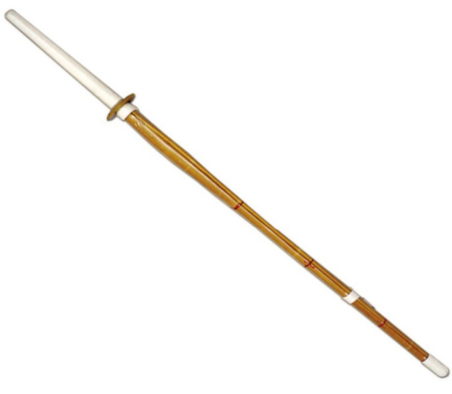
The Modern Revolution: Innovation in the Service of Tradition
Although the manufacture of bamboo katanas is based on an ancient tradition, it has evolved significantly, integrating traditional craftsmanship with today’s technological advances to create even more efficient and durable tools. This evolution does not seek to replace the ancestral art, but to complement it, optimizing production and improving the characteristics of the swords for contemporary practitioners.
Improved materials have played a fundamental role in this revolution. Today, specific types of bamboo are used, often combined with resins or special treatments, resulting in swords that are more resistant to breakage and, surprisingly, easier to handle due to their optimized balance. New heating and shaping techniques have refined the production process, allowing craftsmen to manipulate bamboo with unprecedented precision, achieving ideal curves and shapes that were previously more difficult to achieve consistently.
The incorporation of different materials together, in what we might call a “hybrid” approach, allows for the creation of swords that are lighter and harder at the same time, ideal for rigorous and constant training. For example, although bamboo katanas are mainly made of bamboo, some modern designs for advanced training or even for display may incorporate elements of other materials. In the context of metal swords, high-quality elastic steels such as 5160 and 9260 are examples of modern materials that allow swords to flex without breaking—a property that shinai makers try to replicate as much as possible with bamboo and its treatments.
In addition, the use of advanced technologies such as computer-aided design (CAD) and, in some cases, 3D printing for specific components or prototypes, contributes to greater consistency and quality in production. These modern tools allow manufacturers to keep the essence of the bamboo katana alive while optimizing it for contemporary users, ensuring that each sword meets the highest standards of safety and performance. This balance between unchanging tradition and current needs is fundamental to the continuous evolution and relevance of these tools in the world of martial arts.
Visual and Ergonomic Appeal: Beauty and Functionality in Harmony
Beyond their functional purpose as training tools, bamboo katanas possess a remarkable aesthetic appeal that makes them objects of beauty and admiration. The very nature of bamboo, with its unique grain patterns and color variations ranging from pale tones to deep golds, makes each sword distinctive and imbued with its own personality. The meticulous selection and preparation of bamboo ensure that it integrates harmoniously with the overall design of the sword, blending the material’s natural beauty with the skill and artistry of the craftsman.
Bamboo handles, known as tsuka in traditional katanas, are not only visually attractive but are also designed to significantly enhance the comfort and performance of the sword during training. An optimal balance in weight and distribution is sought for easy and fluid handling, allowing the practitioner to perform quick and precise movements without excessive fatigue. In addition, high-quality bamboo katanas often incorporate strategically placed impact absorption centers to cushion blows, protecting both the practitioner and the equipment.
The grips are ergonomically designed to comfortably fit the user’s hand, providing a firm and secure hold that is crucial for control and safety. This is often achieved through the traditional wrapping of the handle (tsuka-maki) with materials such as cotton or silk, which not only add texture and grip but also contribute to the overall aesthetics. Durable coatings, carefully applied to the bamboo, ensure greater durability of the sword, protecting it from daily wear and the elements.
These features combine strength and flexibility in a unique way, making bamboo katanas both beautiful and functional, suitable for beginners taking their first steps in martial arts as well as experts seeking a high-performance training tool. The harmony between form and function is one of the reasons these swords are so valued.
Cultural Significance and Use in Martial Arts
Bamboo katanas transcend their role as mere training tools; they are bearers of a rich history and deep cultural significance, rooted in Asian combat traditions. They symbolize fundamental values such as respect, self-control, discipline, perseverance, and the pursuit of inner peace. For martial arts practitioners, these tools have been and continue to be fundamental in shaping martial disciplines, especially Kendo.
In Kendo, an ancient Japanese martial art that literally translates as “the way of the sword,” bamboo swords called shinai are used for combat and practice. Kendo was originally developed as a safe and effective training method for samurai, allowing them to perfect their sword skills without the danger of steel blades. It fuses ancestral sword movements with modern concepts of safety and ethics, keeping alive the spirit of wooden sword combat.
Each bamboo katana, especially the shinai, is a fragment of history, uniting the past with the present and allowing practitioners to connect with a deep cultural legacy. Through practice with these swords, kendoka not only learn combat techniques but also internalize the philosophical principles of Kendo, such as courtesy, integrity, and honor. The shinai is not just a weapon; it is a means for personal and spiritual growth.
In addition to the shinai, it is important to mention the bokken, another wooden practice sword, often made of oak or beech, which is also used in various Japanese martial arts such as Aikido, Kendo (for katas), and Iaido. While the shinai is flexible and used for contact sparring, the bokken is a rigid replica of a katana, used to practice forms (katas) and techniques that require the feel of a solid sword. Although not made of bamboo, the bokken shares the spirit of being a safe practice tool that simulates the real sword.

The choice between a shinai and a bokken will depend on the type of training and the specific discipline. For free sparring and armored practice in Kendo, the shinai is indispensable. For studying forms, practicing suburi (individual strikes), or training in other martial arts that do not involve heavy contact, the bokken is the preferred tool. Both are essential for the comprehensive development of the martial arts practitioner.
Benefits of Bamboo Katanas for Kendo and Other Martial Arts
Bamboo katanas, especially shinai, are a popular and virtually indispensable option among Kendo practitioners and other martial disciplines for a multitude of compelling reasons. Their design and the inherent properties of bamboo offer significant advantages that make them superior to other practice tools in certain contexts.
Safety and Risk Reduction
- Flexibility and Impact Absorption: Bamboo’s most outstanding feature is its flexibility. Unlike metal swords or even rigid bokken, the shinai flexes on impact, distributing the force and drastically reducing the risk of serious injury for both attacker and defender. This allows for more realistic and vigorous contact training without compromising safety.
- Less Danger: Without a real edge and being lighter, bamboo swords minimize the inherent danger of weapons practice. This is crucial in training environments where practitioners’ safety is the top priority.
Performance and Skill Development
- Lightness and Agility: Bamboo is an inherently light material, allowing users to perform quick, fluid, and agile movements. This feature is essential for mastering Kendo techniques, which require speed, precision, and rapid transitions between stances and attacks. The lightness facilitates repetition of movements and the development of specific muscular endurance.
- Realistic Simulation: Although safe, bamboo katanas are designed to simulate the weight and balance of a real katana, allowing practitioners to develop an authentic feel for the weapon. This is vital for skill transfer to a metal sword if the practitioner advances to that stage.
- Impact Response: The way the shinai reacts to impact is key to learning. Practitioners can feel the quality of their strikes and the effectiveness of their blocks, providing invaluable feedback to improve their technique.
Economy and Maintenance
- More Affordable: Compared to metal training katanas or even some bokken made of exotic woods, bamboo swords are significantly more affordable. This makes them accessible to a wider audience and for regular practice, where wear and tear is inevitable.
- Easy Maintenance: Although they require care, bamboo is relatively easy to clean and maintain. With proper maintenance (cleaning, inspection, and part replacement), a bamboo katana can last a long time, reducing long-term costs. Individual shinai parts (bamboo slats, leather) are often replaceable, which extends the sword’s lifespan.
- Durability: Because bamboo is a durable and resilient material, bamboo swords can withstand the rigors of daily training if properly cared for. Their ability to flex and absorb impacts also contributes to their longevity.
In summary, the benefits of bamboo katanas for Kendo practice are multifaceted, ranging from safety and economy to optimal skill development. They are an essential tool that allows practitioners to fully immerse themselves in the martial art with confidence and effectiveness.
Tips for Choosing Bamboo Katanas for Kendo
When choosing a bamboo katana for Kendo practice, it is crucial to consider several factors to ensure you are getting the best option suited to your individual needs and level of experience. The right choice will not only improve your performance but also ensure your safety and the durability of your equipment.
1. Sword Length and Weight
The length and weight of the shinai are fundamental factors. Most bamboo swords come in standard sizes that correspond to the practitioner’s age and gender, as well as Kendo federation regulations. It is imperative to choose a sword that matches your height and physical strength so you can handle it easily and execute techniques correctly. A shinai that is too long or heavy can make control difficult, while one that is too short or light may not provide the necessary resistance for effective training.
- For beginners: A shinai that is not excessively heavy is often recommended to facilitate learning basic movements.
- For experts: Advanced practitioners may prefer shinais with a specific balance or slightly different weight to optimize their techniques.
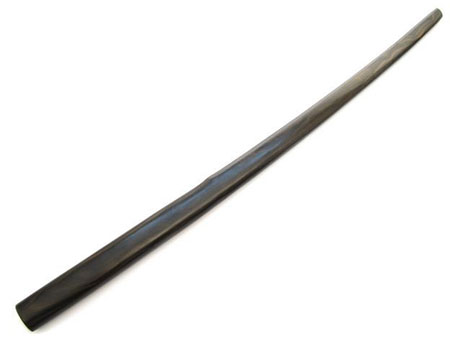
2. Material Quality and Construction
The quality of the bamboo is paramount. Make sure to choose a sword made from high-quality bamboo, preferably from varieties known for their strength and flexibility, such as madake bamboo. The quality of the material will ensure its durability and resistance during intense practice. Low-quality bamboo can crack or break easily, which is not only frustrating but also dangerous.
- Visual inspection: Look for shinais with uniform bamboo slats, no visible cracks or deformations. The color should be consistent.
- Assembly: It is crucial to check that the handle (tsuka) and guard (tsuba) are well secured and firm. Poor assembly can cause parts to come loose during practice, which could lead to injury. The cord that joins the bamboo slats (tsuru) and leather pieces should be tight and in good condition.
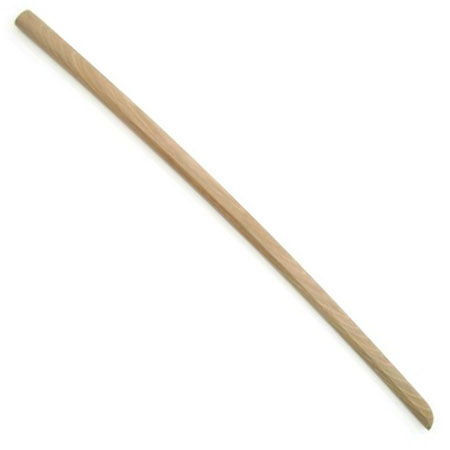
3. Included Accessories and Maintenance
In addition to the sword itself, it is advisable to choose a bamboo katana that comes with a case or cover for proper storage and transport. A case will protect the sword from damage, dust, and moisture, ensuring it is ready for use at all times. Some shinais also come with basic maintenance kits, which is a plus.
- Maintenance kit: Consider acquiring a kit that includes tools to adjust leather parts and the tsuru, as well as oil for the bamboo if necessary.
- Tip protection: Make sure the tip of the shinai (sakigawa) is well protected and in good condition, as it is one of the parts that receives the most impact.
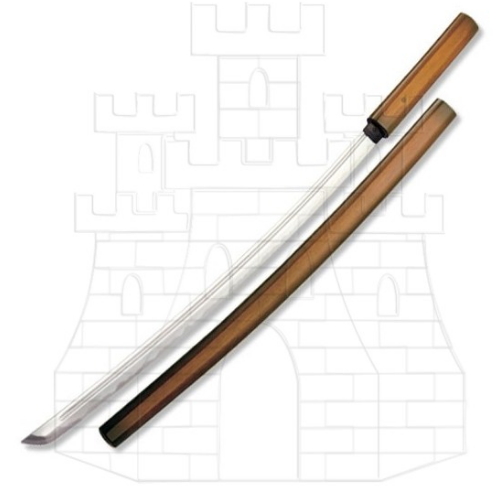
4. Trusted Seller
To ensure the authenticity and quality of your bamboo katana, it is highly recommended to purchase these swords from trusted sellers specializing in martial arts equipment. A good seller will be able to offer you expert advice, a wide range of options, and guarantees on the quality of their products. Avoid cheap imitations that may compromise your safety and the sword’s durability.
By considering these tips, you will be able to choose a bamboo katana that not only meets your performance and safety expectations but also becomes a lasting companion on your martial arts journey.
Sustainability: A Conscious Choice for the Planet
The production of bamboo katanas, especially shinais, represents a significant ecological commitment within the world of martial arts. In an era where environmental awareness is increasingly vital, choosing a sustainable training tool is not just a preference but a statement of values. Unlike their metal counterparts, whose production often involves high energy consumption processes and the use of non-renewable resources, bamboo swords are an inherently more sustainable option due to bamboo’s extraordinary regenerative capacity.
Bamboo is one of the fastest-growing plants on the planet, capable of reaching maturity in just a few years, unlike trees that take decades. Furthermore, its harvest does not require replanting, as the bamboo root system remains intact and continuously produces new shoots. This makes it a highly renewable resource with minimal environmental impact compared to other materials used in tool manufacturing.
Responsible manufacturers of bamboo katanas are increasingly adopting environmentally friendly production methods, actively seeking to minimize waste and reduce energy consumption at all stages of the process. This includes:
- Efficient Use of Material: They strive to use only the bamboo necessary for each sword, optimizing cuts and design to minimize waste.
- Waste Utilization: Bamboo remnants that cannot be used in sword manufacturing are often recycled or find alternative uses, such as biomass production or the manufacture of other bamboo products, thus closing the material’s life cycle.
- Low-Impact Processes: Natural drying techniques and treatments that avoid the use of aggressive chemicals are implemented, reducing the carbon footprint of production.
In addition to manufacturing practices, promoting proper care of the swords by the user also contributes to their longevity, reinforcing the commitment to sustainability. A well-maintained sword does not need to be replaced as often, reducing the demand for new resources. Educating users about the environmental benefits of these swords and how to prolong their useful life is an integral part of this ecological approach. Choosing a bamboo katana is therefore a conscious decision that supports not only martial tradition but also the health of our planet.
Guide for Collectors and Maintenance Tips
Bamboo katanas, with their unique combination of historical value, practical functionality, and aesthetic appeal, attract a growing number of collectors and combat tool enthusiasts. For those looking to add these unique pieces to their collection or simply want to ensure the longevity of their training tool, it is essential to understand what to look for and how to properly care for them.
Guide for Collectors
When choosing a bamboo katana for collection purposes, it is important to consider several aspects that go beyond mere functionality:
- Blade Appearance (Shinai): Observe the quality of the bamboo, the uniformity of the slats, and the absence of significant imperfections. Some high-end bamboo katanas may display unique patterns in the bamboo that are aesthetically desirable.
- Craftsmanship: Research how the bamboo was used in its manufacture. Pieces made by renowned craftsmen or with specific traditional techniques may have higher collectible value. The quality of the assembly of leather parts and the tsuru (cord) is also an indicator of superior craftsmanship.
- Suitability for Modern Practice vs. Historical Value: Some bamboo katanas may be historical replicas or display pieces not designed for the rigors of modern training. Be sure to understand their purpose. For practice, durability and safety are paramount; for collection, authenticity and aesthetics may be more important.
- Authenticity and Trusted Sellers: To ensure authenticity and quality, it is highly recommended to purchase these swords from trusted sellers, specialists in Japanese martial arts equipment, or distributors with an established reputation. This minimizes the risk of acquiring low-quality imitations.
Maintenance Tips to Prolong Useful Life
To prolong the useful life and maintain the excellent condition of your bamboo katana, whether a training shinai or a collector’s piece, proper and consistent care is essential. Regular maintenance not only preserves the beauty and functionality of the sword but also ensures safety during use.
- Proper Storage: Store the sword in a cool, dry, and well-ventilated place to avoid warping, cracking, or damage caused by humidity or sudden temperature changes. Avoid direct exposure to sunlight or heat sources. A protective case or cover is ideal for storage.
- Regular Cleaning: Clean it regularly with soft, dry cloths to remove dust and dirt. If necessary, you can use a slightly damp cloth with water and a neutral soap, ensuring the sword is completely dry afterward. This helps preserve the natural beauty and flexibility of the bamboo.
- Frequent Inspection: Frequently inspect the sword for any signs of wear, such as cracks in the bamboo slats, loose parts in the handle or tsuba, or deterioration of cords and leather. Pay special attention to the tip (sakigawa) and the base of the handle.
- Necessary Repairs: Make necessary repairs immediately. This may include tightening loose components, replacing damaged bamboo slats, renewing leather parts, or tightening the tsuru. Many shinais are designed so that their components are replaceable, which significantly extends the sword’s lifespan. Do not use a damaged sword, as it could be dangerous.
- Safety and Careful Handling: Always handle your bamboo katana with care and respect. Avoid unnecessary impacts against hard surfaces and follow the usage and safety instructions of your dojo or instructor. Safety and careful handling are paramount for the sword’s longevity and the practitioner’s safety.
With diligent care, your bamboo katana will not only be an effective training tool but also a durable piece that will accompany you for many years on your martial journey.
Bamboo katanas are an eloquent testament to how ancient tradition and modern innovation can coexist harmoniously, creating tools that are functional, safe, and culturally rich. We have explored their fascinating historical origins, the artisanal mastery that shapes them, the modern adaptations that have perfected them, their undeniable aesthetic and ergonomic appeal, their deep cultural significance in disciplines such as Kendo, their multiple training benefits, essential tips for their selection, and their important role in environmental sustainability.
Whether you are a collector passionate about the history of Japanese weapons, a dedicated Kendo practitioner seeking the perfect training tool, or an occasional adventurer wanting to explore the art of the bamboo sword, understanding the richness these swords offer and the care they require is essential. Bamboo katanas represent a perfect fusion between past and present, offering a culturally profound and environmentally conscious option in the art of Japanese sword making and the path of martial arts.

If you are looking for your next bamboo katana, a high-quality shinai for Kendo, or perhaps a sturdy bokken for your katas, we invite you to explore the wide selection available in our Bamboo Katanas collection. You can also discover our variety of Bokken swords, perfect for all ages and experience levels. Find the ideal tool to accompany you on your martial journey!











